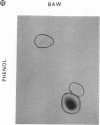Abstract
The enzymic formation of acetylglutamate has been studied in Chlorella vulgaris extracts. Acetyl CoA and N2-acetyl-l-ornithine served as substrates for glutamate acetylation whereas acetylphosphate, N5-acetyl-l-ornithine, and N2-acetyl-2,4-diamino butyrate were ineffective. Acetyl CoA-glutamate transacetylase and acetylornithine-glutamate transacetylase activities have been purified over 180-fold with no indication of any separation of activities. The acetyl CoA activity was more labile than acetylornithine activity so that preparations having acetylornithine-glutamate transacetylase activity but no acetyl CoA-glutamate transacetylase activity were obtained. The two acetylating activities appear to be properties of one enzyme with one portion more easily denatured.
Both acetylating activities had pH optima between 8 and 8.5. The Km value for glutamate was 3 mm for both activities. The Km values were 0.2 mm for acetylornithine and 3.2 mm for acetyl CoA. Arginine inhibited acetyl CoA-glutamate transacetylase (Ki = 0.94 mm) and acetylglutamate phosphokinase (Ki = 0.5 mm) but had no effect on acetylornithine-glutamate transacetylase. The lack of an inhibitory effect of proline on any of the three enzymic activities indicates that acetylglutamate is not a normal intermediate in proline biosynthesis. Growth of Chlorella with arginine as a nitrogen source had no effect on enzyme levels, showing that end-product repression is not a control factor in arginine biosynthesis in Chlorella. In Chlorella, arginine controls its own biosynthesis by inhibiting acetylglutamate phosphokinase and controls the level of acetylated intermediates by inhibiting acetyl CoA-glutamate transacetylase.
Full text
PDF







Images in this article
Selected References
These references are in PubMed. This may not be the complete list of references from this article.
- Baker J. E., Thompson J. F. Metabolism of Urea & Ornithine Cycle Intermediates by Nitrogen-Starved Cells of Chlorella vulgaris. Plant Physiol. 1962 Sep;37(5):618–624. doi: 10.1104/pp.37.5.618. [DOI] [PMC free article] [PubMed] [Google Scholar]
- Böhlen P., Stein S., Dairman W., Udenfriend S. Fluorometric assay of proteins in the nanogram range. Arch Biochem Biophys. 1973 Mar;155(1):213–220. doi: 10.1016/s0003-9861(73)80023-2. [DOI] [PubMed] [Google Scholar]
- DEDEKEN R. H. BIOSYNTH'ESE DE L'ARGININE CHEZ LA LEVURE. I. LE SORT DE LA N-ALPHA-AC'ETYLORINITHINE. Biochim Biophys Acta. 1963 Dec 13;78:606–616. doi: 10.1016/0006-3002(63)91026-6. [DOI] [PubMed] [Google Scholar]
- FAHIEN L. A., SCHOOLER J. M., GEHRED G. A., COHEN P. P. STUDIES ON THE MECHANISM OF ACTION OF ACETYLGLUTAMATE AS AN ACTIVATOR OF CARBAMYL PHOSPHATE SYNTHETASE. J Biol Chem. 1964 Jun;239:1935–1941. [PubMed] [Google Scholar]
- Faragó A., Dénes G. Mechanism of arginine biosynthesis in Chlamydomonas reinhardti. II. Purification and properties of N-acetylglutamate 5-phosphotransferase, the allosteric enzyme of the pathway. Biochim Biophys Acta. 1967 Feb 7;136(1):6–18. doi: 10.1016/0304-4165(67)90315-7. [DOI] [PubMed] [Google Scholar]
- Garrett R. H., Nason A. Further purification and properties of Neurospora nitrate reductase. J Biol Chem. 1969 Jun 10;244(11):2870–2882. [PubMed] [Google Scholar]
- Hoare D. S., Hoare S. L. Feedback regulation of arginine biosynthesis in blue-green algae and photosynthetic bacteria. J Bacteriol. 1966 Aug;92(2):375–379. doi: 10.1128/jb.92.2.375-379.1966. [DOI] [PMC free article] [PubMed] [Google Scholar]
- LOWRY O. H., ROSEBROUGH N. J., FARR A. L., RANDALL R. J. Protein measurement with the Folin phenol reagent. J Biol Chem. 1951 Nov;193(1):265–275. [PubMed] [Google Scholar]
- Lesinger T., Haas D., Hegarty M. P. Indospicine as an arginine antagonist in Escherichia coli and Pseudomonas aeruginosa. Biochim Biophys Acta. 1972 Mar 14;262(2):214–219. doi: 10.1016/0005-2787(72)90235-3. [DOI] [PubMed] [Google Scholar]
- MORRIS C. J., THOMPSON J. F. The isolation and characterization of gamma-L-glutamyl-L-tyrosine and gamma-L-glutamyl-L-phenylalanine from soybeans. Biochemistry. 1962 Jul;1:706–709. doi: 10.1021/bi00910a026. [DOI] [PubMed] [Google Scholar]
- Maas W. K., Novelli G. D., Lipmann F. Acetylation of Glutamic Acid by Extracts of Escherichia Coli. Proc Natl Acad Sci U S A. 1953 Oct;39(10):1004–1008. doi: 10.1073/pnas.39.10.1004. [DOI] [PMC free article] [PubMed] [Google Scholar]
- Morris C. J., Thompson J. F. Conversion of m-carboxyphenylalanine to m-carboxyphenylglycine in Wedgewood iris leaves. Arch Biochem Biophys. 1965 Jun;110(3):506–510. doi: 10.1016/0003-9861(65)90443-1. [DOI] [PubMed] [Google Scholar]
- Morris C. J., Thompson J. F., Johnson C. M. Metabolism of Glutamic Acid and N-Acetylglutamic Acid in Leaf Discs and Cell-free Extracts of Higher Plants. Plant Physiol. 1969 Jul;44(7):1023–1026. doi: 10.1104/pp.44.7.1023. [DOI] [PMC free article] [PubMed] [Google Scholar]
- Nason A., Antoine A. D., Ketchum P. A., Frazier W. A., 3rd, Lee D. K. Formation of assimilatory nitrate reductase by in vitro inter-cistronic complementation in Neurospora crassa. Proc Natl Acad Sci U S A. 1970 Jan;65(1):137–144. doi: 10.1073/pnas.65.1.137. [DOI] [PMC free article] [PubMed] [Google Scholar]
- Roon R. J., Levenberg B. CO2 fixation and the involvement of allophanate in the biotin-enzyme-catalyzed cleavage of urea. J Biol Chem. 1970 Sep 10;245(17):4593–4595. [PubMed] [Google Scholar]
- Rosen B. P. Basic amino acid transport in Escherichia coli. J Biol Chem. 1971 Jun 10;246(11):3653–3662. [PubMed] [Google Scholar]
- Shigesada K., Tatibana M. Enzymatic synthesis of acetylglutamate by mammalian liver preparations and its stimulation by arginine. Biochem Biophys Res Commun. 1971 Sep;44(5):1117–1124. doi: 10.1016/s0006-291x(71)80201-2. [DOI] [PubMed] [Google Scholar]
- Sorger G. J., Giles N. H. Genetic control of nitrate reductase in Neurospora crassa. Genetics. 1965 Oct;52(4):777–788. doi: 10.1093/genetics/52.4.777. [DOI] [PMC free article] [PubMed] [Google Scholar]
- Staub M., Dénes G. Mechanism of arginine biosynthesis in Chlamydomonas reinhardti. I. Purification and properties of ornithine acetyltransferase. Biochim Biophys Acta. 1966 Oct 17;128(1):82–91. doi: 10.1016/0926-6593(66)90144-5. [DOI] [PubMed] [Google Scholar]
- THOMPSON J. F., GERING R. K. Preparation of N alpha-acetylornithine. Arch Biochem Biophys. 1962 Nov;99:326–327. doi: 10.1016/0003-9861(62)90018-8. [DOI] [PubMed] [Google Scholar]
- Whitney P. A., Cooper T. G. Requirement for HCO3- by ATP: urea amido-lyase in yeast. Biochem Biophys Res Commun. 1970 Aug 24;40(4):814–819. doi: 10.1016/0006-291x(70)90975-7. [DOI] [PubMed] [Google Scholar]
- Whitney P. A., Cooper T. G. Urea carboxylase and allophanate hydrolase. Two components of adenosine triphosphate:urea amido-lyase in Saccharomyces cerevisiae. J Biol Chem. 1972 Mar 10;247(5):1349–1353. [PubMed] [Google Scholar]



